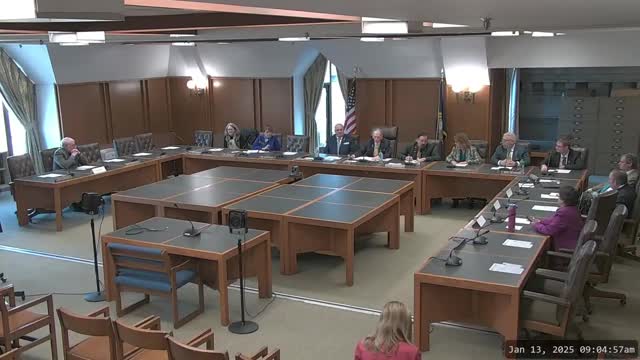Committee chair opens Science, Technology and Energy orientation, outlines rules for members and public hearings
January 13, 2025 | Science, Technology and Energy, House of Representatives, Committees , Legislative, New Hampshire
This article was created by AI summarizing key points discussed. AI makes mistakes, so for full details and context, please refer to the video of the full meeting. Please report any errors so we can fix them. Report an error »

Michael Vos, chair of the Science, Technology and Energy Committee, opened the committee’s kickoff orientation for the 2025–2026 legislative session and told members the first hour would be “committee orientation,” during which the panel would cover how the committee operates and the two principal activities — public hearings and executive sessions.
Vos urged members to arrive before the committee’s usual 9 a.m. start, to notify their caucus leader when they cannot attend, and to follow basic office and meeting decorum. He noted practical logistics — coat racks in the hallway, limited space for belongings in the committee office, and individual filing drawers for members to store materials.
The chair told members that food and beverages are not allowed except drinking water, and that members who need to step out or use electronic devices during a hearing should do so out in the hallway. “These meetings are being recorded,” Vos said, noting the recordings are posted to the committee’s YouTube channel so members can review testimony later.
Vice Chair Doug Thomas and ranking member Kat McGee supplemented the ground rules. Thomas cautioned members that their posture and device use are visible on livestreams and urged restraint: “Be aware that you are being looked at and your actions could be viewed by the public in certain ways that you don't intend,” he said. McGee described a caucus practice of maintaining a shared Google sheet to track bills, links, hearings and votes so new members can follow committee business.
The vice chair and clerk JD Bernardi reviewed hearing procedure: people who wish to testify should complete the pink witness card and the chair will call speakers in the order collected; witnesses may submit written testimony and are expected to keep oral remarks concise so the committee can hear other speakers. Members who are sponsors or cosponsors should not both testify and then ask follow-up questions; if a sponsor testifies the member will return to the table and not take questions from the witness panel. Bernardi walked members through how executive sessions will be run, including the requirement for a quorum, the order of motions (amendments first, then a committee recommendation such as “ought to pass” or “inexpedient to legislate”), and preparation of majority and minority committee reports.
Members were also given administrative instructions about in-room storage, assignment of a security-notification contact for the committee, and where to go in an emergency. Committee staff told members how to request constituent and committee services and reminded them that committee reports must be clear summaries of testimony and facts rather than expressions of personal opinion.
Vos closed the orientation portion by inviting the Department of Energy to present, and told members the committee would continue orientation items (such as a discussion of executive sessions) at a later meeting if necessary.
Vos urged members to arrive before the committee’s usual 9 a.m. start, to notify their caucus leader when they cannot attend, and to follow basic office and meeting decorum. He noted practical logistics — coat racks in the hallway, limited space for belongings in the committee office, and individual filing drawers for members to store materials.
The chair told members that food and beverages are not allowed except drinking water, and that members who need to step out or use electronic devices during a hearing should do so out in the hallway. “These meetings are being recorded,” Vos said, noting the recordings are posted to the committee’s YouTube channel so members can review testimony later.
Vice Chair Doug Thomas and ranking member Kat McGee supplemented the ground rules. Thomas cautioned members that their posture and device use are visible on livestreams and urged restraint: “Be aware that you are being looked at and your actions could be viewed by the public in certain ways that you don't intend,” he said. McGee described a caucus practice of maintaining a shared Google sheet to track bills, links, hearings and votes so new members can follow committee business.
The vice chair and clerk JD Bernardi reviewed hearing procedure: people who wish to testify should complete the pink witness card and the chair will call speakers in the order collected; witnesses may submit written testimony and are expected to keep oral remarks concise so the committee can hear other speakers. Members who are sponsors or cosponsors should not both testify and then ask follow-up questions; if a sponsor testifies the member will return to the table and not take questions from the witness panel. Bernardi walked members through how executive sessions will be run, including the requirement for a quorum, the order of motions (amendments first, then a committee recommendation such as “ought to pass” or “inexpedient to legislate”), and preparation of majority and minority committee reports.
Members were also given administrative instructions about in-room storage, assignment of a security-notification contact for the committee, and where to go in an emergency. Committee staff told members how to request constituent and committee services and reminded them that committee reports must be clear summaries of testimony and facts rather than expressions of personal opinion.
Vos closed the orientation portion by inviting the Department of Energy to present, and told members the committee would continue orientation items (such as a discussion of executive sessions) at a later meeting if necessary.
View full meeting
This article is based on a recent meeting—watch the full video and explore the complete transcript for deeper insights into the discussion.
View full meeting
